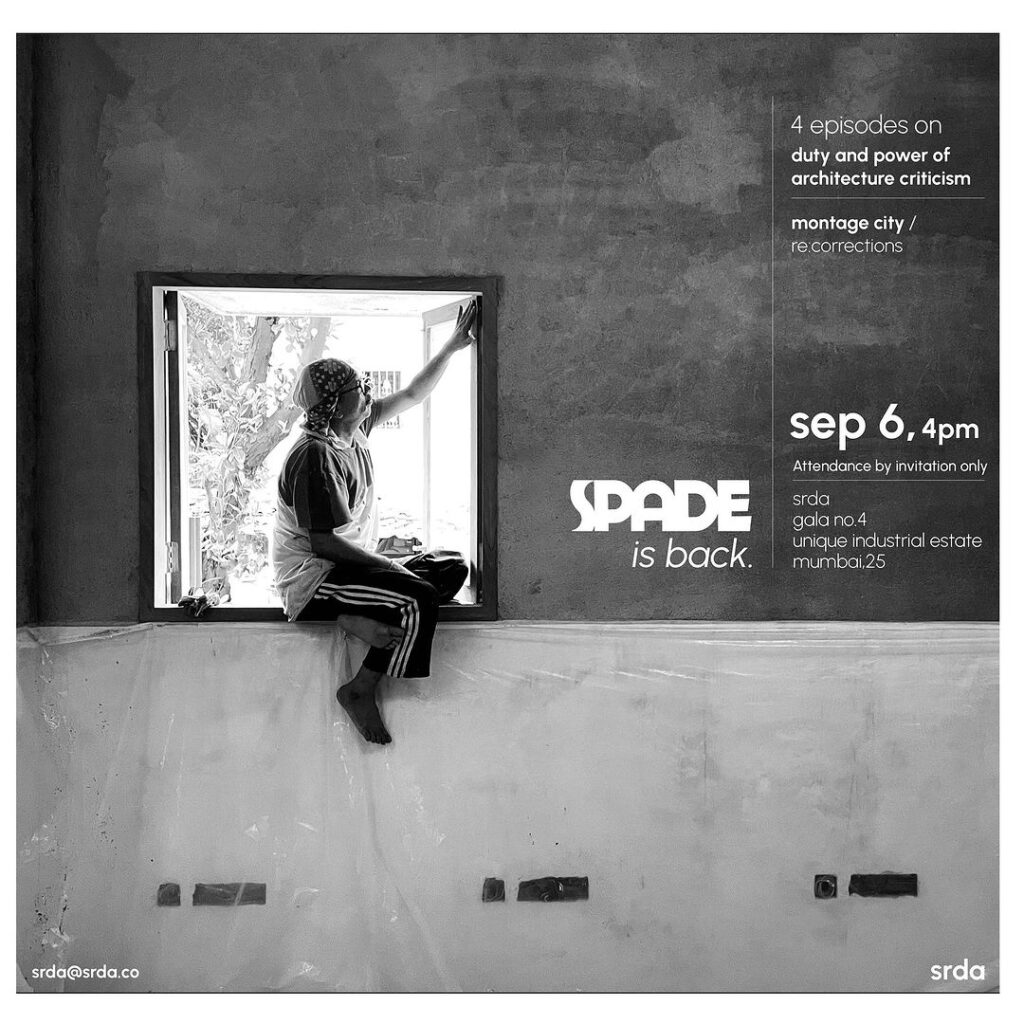
Introduction
Organised as a closed-door event in a private space with “attendance by invitation only” and no “inhabitants” or “people at large” in the crowd of architects, it seemed to be filled with contradictions from the word go. However, at a time when all forms of criticism by the architectural media (limited to begin with) have disappeared, the need for these discussions becomes paramount.
Whilst these discussions happen continually and rigorously by the few architects who choose to engage with academics in some of the good schools, the space for them to happen in professional circles simply does not exist, period! The geographical stretch of the city along with the unfounded pressures of operating in Mumbai only further compounds the problem. Thus, the effort to bring a group of professionals across age groups, from senior practitioners to students, needs to be lauded and hopefully, with further iterations over time, creates a critical space as desired for not only discussion but also reflection.
Student Presentations
Two modules with similar ideas of architectural explorations concerning the resurrection of abandoned buildings in Mumbai—’Re:Corrections’ and ‘Montage City’—conducted by Arjun Malik, Samira Rathod, and Yash Gorecha as part of the Bridge Studio at KRVIA presented their work in progress.
Whilst the idea of discussing student and professional work in the same space and event is interesting, far more rigorous forums (like the KVDF at CEPT University, the Thesis Colloquium at KRVIA, Rookies Award at PVPCOA, etc.) exist to do justice to the student work, which was cursorily dismissed by the senior practitioners with a pat on the back without going into the specifics of either critiquing the studio intention, process, or projects.
This distancing between the two is the exact reason why the Bridge Studio was conceptualised during my time as Dean Academics at the KRVIA and to help build a culture of critique amongst practicing professionals. When we conceptualised the Bridge Studio, I had already been teaching for almost 15 years and was becoming aware of the dangers of institutions becoming echo chambers.
There was also a growing distance between academia and the profession, maybe partly due to the nature of Mumbai or maybe partly due to the lack of effort on the part of either to even meet each other halfway.
There was a need to bring outside voices to contaminate and corrupt the idealism of the academy and vice-versa. But institutions also cannot escape their role to engage, enhance, and build up the profession besides the discipline alone. They need to create a space and time for reflection for the practitioner and to draw them out from the quotidian nature of practice. In that context, it was heartening to see the Bridge Studio finally leave the confines of the institute and begin to take these conversations and critiques into practice and city.
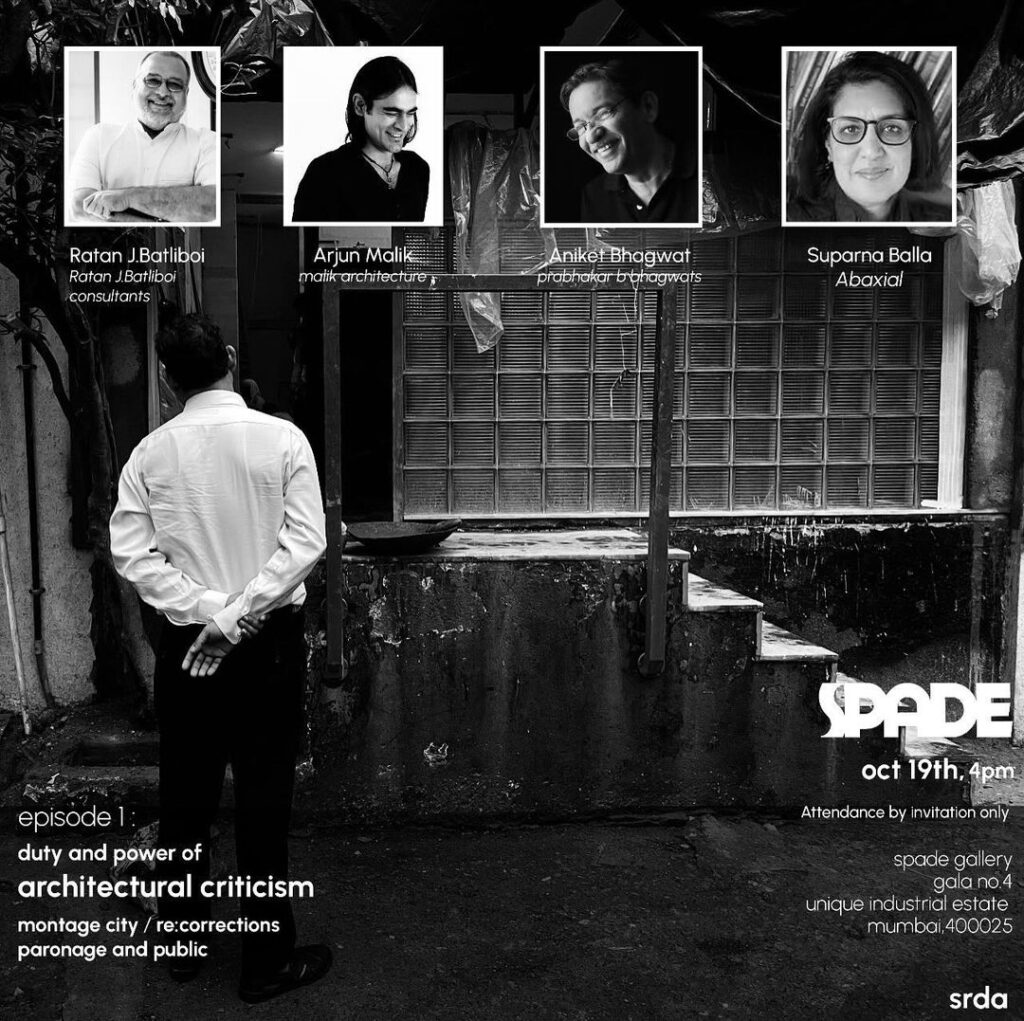
Professional Presentations
Except for the first, all the other presentations exceeded their time! I like to joke that there is great danger in giving a mic to most architects—we love hearing our own voices so much that keeping time becomes unimportant (guilty as charged myself) and maybe the reason that the Pecha Kucha format of presentation was devised.
However, I am torn between this 2-minute-tification of projects that have sometimes seen up to 5 years or more coming to fruition. Whilst this forces the designer to talk only about the most important core issues, a longer and more detailed, in-depth presentation allows for engagement with processes, doubts, anxieties, failures, and learnings along the way.
If conversation and critique are the focus, what is the right space for the same?
But all four presentations made me reflect beyond the architecture itself, and in that, part of the purpose of the event was achieved. It was interesting to see a Landscape Architect as part of the mix, and I hope other allied practitioners are included in future iterations to look at alternate positions, methods, and worldviews.
What do these collectively say about the spectrum of both opportunities and problems that plague our cities and the profession in general? Interestingly, Aniket opened with the idea of patronage—and maybe that clouded my judgement for the rest of the evening. But I feel it would be interesting to frame all four presentations through this lens, as it seems to be symptomatic of the state of the profession and where we seem to find ourselves in society! Traversing in reverse order of the presentations reveals an interesting scenario.
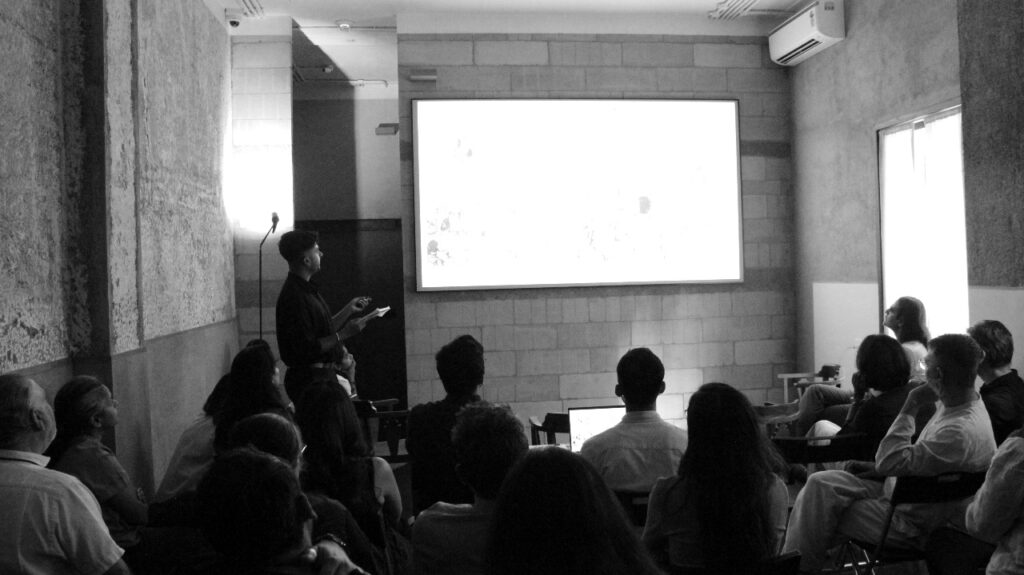
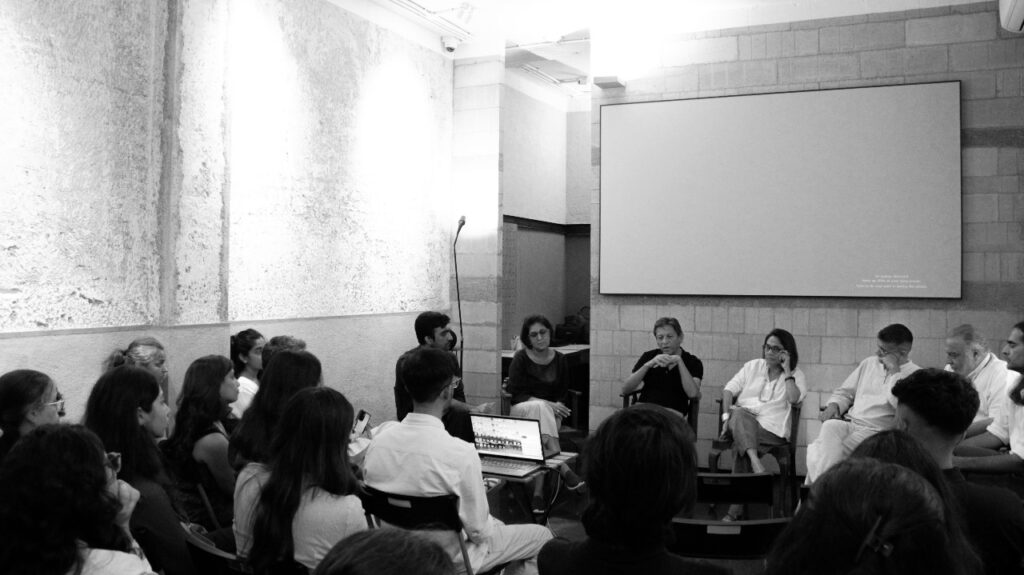

SECMOL University, Ladakh / Patronage of the Reluctant Professional
The presentation of a landmark project situated in the pristine landscape of Ladakh for a visionary like Sonam Wangchuck raised more questions than it answered, but not in the expected way. Shouldn’t patronage begin first and foremost with the practitioner being devoted to their discipline and craft?
The seemingly self-deprecating prolix narrative of the presentation, unfortunately, exposed the detachment of the practitioner and complete disengagement with the issues at hand. Has the architect become a mere tool for the client to use at will? Wasn’t our ask to do everything in the brief and way beyond, even when there was nothing like a brief to begin with? Isn’t the power of that landscape not enough for us to “read” place and potential and develop our own brief? How would milestone projects like this manifest if they fell in the right hands—either through open/invited competition or sparked by the curious naivete and dedicated enthusiasm of a young practitioner—both working with local collaborators?

Museum of Solutions, Mumbai / Patronage (or lack of) by the Client
In the Indian context, museums used to be initiated only by government patronage, but we are increasingly seeing private entities and corporations initiate these across the country.
Will these projects freed from bureaucratic restraints remain truly “public,” and will their designers truly understand the nature of publicness they need to embody, will remain to be seen?
The Museum of Solutions, or MuSo as branded, is a collaboration between a senior established practice and a young tech-savvy firm (Bricolage Mumbai). What seemed to be an ideal “debut” project of a client slowly unravels to derail itself by the end. Is it the immaturity of the “young” client, the forces of the city at play, the inability of the designers to strategically address the core issues or all of the above—one will never truly know.
But the end result is what the city produces ad-nauseam—an extruded volumetric wrapper that engulfs the entire site, much like the multiple capitalist erections in the city, in the emperor’s new clothes. This results in the complete erasure of/non-creation of public space—a fundamental ask of the architecture of the museum as a “public” institution.
Given the impotence of the architecture, all focus quickly shifts entirely to the insides—the “interior” remaining the only space for the designer to “intervene” in. It seems to be lost on the designer that the exhibits inside—though meaningfully conceptualised—will constantly evolve and change over time but the architecture will survive. What, then, does it have to say?
Is this what the city has become—glossy, finished insides where unheard amounts of resources are expended, with not a thought to anything outside its threshold? Maybe the Museum needs to ask its bright young audience of untainted minds for an urgent “solution”!

IF:BE, Mumbai / Patronage of Individual Privilege
Similar to MuSo, IF:BE, at a much smaller scale, is an attempt by concerned individuals to reclaim the public role of architecture whilst preserving a part of the city as it existed in the past and what it could transform into the future. Not driven solely by profit alone (“profit” not necessarily being a bad word as mentioned in the discussion—just in the wrong hands), there remain individuals who want to use available means to make a difference where possible.
In this self-initiated family project, the architect was honest enough to admit his temperamental inability to be an activist and alternatively searching for a means to intervene in the public realm. Given the complexities of repair and reuse, the honest architectural response and resolution were of course well explained and very competently handled, resulting in evocative spaces that respectfully balanced the old and the new. But most importantly, it has created a successful new cultural space in the city—much in line with the original intention.
Whilst the project can be cited for being a product of privilege, is it also symptomatic of the privatisation of the public realm (like MuSo) that we are seeing all around us?
Is it all good till the sponsors are sensitive and concerned about nuance, but what happens if it ends up in the wrong hands eventually, or when the lease runs out? But that shouldn’t stop one from trying, should it?
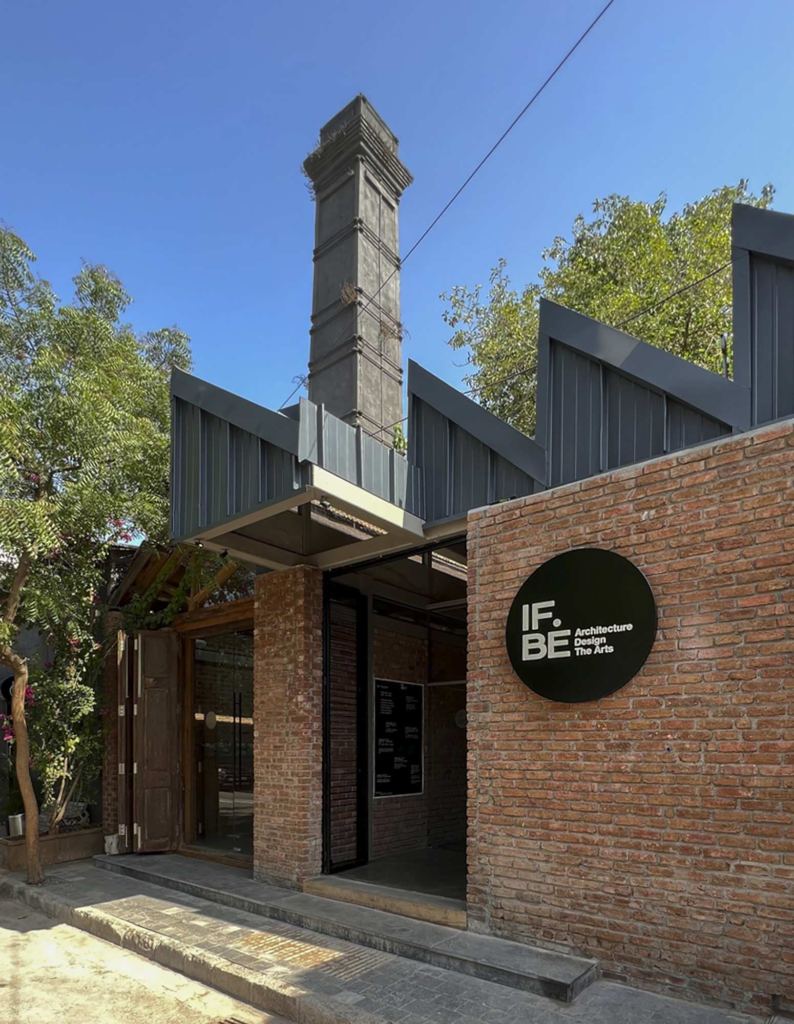
Public Gardens in Gujarat / Altruistic Patronage
Public gardens largely built in Ahmedabad and other cities in Gujarat initiated by the local municipal corporations showed an exemplary way forward not only in design and execution but also in maintenance. Unlike some of the firm’s other works that could be accused of oscillating between being deterministic and mannered, these gardens, slightly unkempt, unmanicured, and with their rough edges and frayed ends, seem more un-designed, effortless, and humane.
Nonetheless, the core planning and good bones of planting hold it all together and hopefully will make them survive idiosyncratic political cycles. The exemplary gardens presented not only show nature’s ability to provide respite in the urban but also that it is indeed possible with political will, true patronage (through corporate CSR) and professional dedication and involvement to make a difference in the public realm to create truly inclusive democratic public spaces that sing and are full of joy and beauty! Somehow it is always nature that seems to show the way… there is hope after all!
In summary
Besides these very broad, overarching implications, there is, of course, the discourse one can build around the specificity of the object itself, but these larger concerns seem to upend that discussion.
Whilst the complexity of doing public projects in India is well understood and acknowledged, does it relieve the architect from their responsibilities to the discipline and the public at large?
Each of the four projects eventually throws light on the role of the architect, the client, and the public users as well.
Samira Rathod’s response to Pinkish Shah’s Critique
Your erudite notes and comments are well taken and your commitment to SPADE is indeed highly appreciated. You are right that by making this a closed-door event, it hardly seems to have taken “public ” into account.
Unfortunately, we have space constraints and limited seating, and this being a debut event, one was also testing the waters. But like you said, more importantly, it was to really get people triggered for discussion as most such events end up with party babble; ‘closed doors’ and ‘invitees only’ keep a good filter on the quality of the conversation.
But having said that, your point is noted and let me see how we can make this far more inclusive and reach out to many more, though some of us feel its best kept small and tight for the really interested, and that speakers may talk more candidly and we may have unbridled conversations.
I am glad that you have enjoyed the session and were allowed to open dialogue here online as well, with your note being circulated to all the panelists and a few more.
Students presentations : KRVIA students/Vertical Studio
This wasn’t the place for a critique that is offered in school, but open it to a larger idea of urbanity in its making as seen through the lens of the project undertaken.
That students could be exposed to such abstract ideas of film and its indirect influence of design and architecture was lauded by the panelist in general. It did elicit some interesting comments from the audience and was an encouragement to the students as well as an exposure for them to be presenting alongside practicing senior architects, allowing peripheral learning as well.
Architects presentations: Aniket Bhagwat, Arjun Mallik, Ratan Batliboi, Suparna Bhalla
In all fairness, to all speakers, whilst they did perhaps overrun on time, were generous to have travelled and taken the time out and offered their work for discussion and questioning .
The nature of such conversations is spontaneous and it takes the direction the panelists decide based on a thread that may be offered in the day’s presentations and hence remains unmonitored, and that is the construct/format of these episodes.
The constructive criticism was not to objectively scrutinise each move in the design strategy but to review and understand the architect’s larger motivations, challenges, and hence outcomes and its impact on the public realm. Each project was, in that sense, hugely beneficial and successful.
Exquisite as it was, Aniket’s presentation is not one that draws an argument of design nor does it require one.
The larger question, and especially in our context, of means and privileges of the common man being limited or even absent, is one of providing and patronage, private, corporate, or public (by the government).
I believe you had to leave early and missed the discussion that followed.
Primarily, though short, it drew a conversation, where all admittedly agreed that if there had to be a larger impact, one would have to work with the government, without a personal agenda, with an understanding to help, and selflessly.
There is always the angst, the hands-tied situation, a negotiation, and suasion in the final outcome of the project, and only and only unless the patronage is alive to the need of a higher aesthetic, a belief and trust in the designer to allow experimentation, innovation, and even failure, there could be no ways forward to newer and more responsive outcomes and a vivacious urbanity. This isn’t the responsibility of the architect alone but as with all public projects, it is the joint venture of the patron public and designer, each stakeholder being a team player and not out for his own runs!
This belief and trust have to be commanded and have to be demonstrated through persistent and consistent work without self-gain, in the interest of the project alone.
These are the underpinnings I took home from the discussion and conversation, which, broad-based as they are, are far more meaningful.
Suparna has a fantastic body of work that she has kept secret. She is one of the few women architects in the country that has not yet gotten her due. Her portfolio boasts of a variety of projects—from theatres, schools, colleges, to community centres—and not to mention the university in Ladakh! The presentation wasn’t enough and she nonchalantly batted off the struggle of working on such terrain that I wished she had spoken of more.
Ratan’s repertoire is huge; it goes back to being the one of the few foremost architects to have worked with the government and built some amazing railway stations within the means afforded to him.
Arjun, the IF.BE Centre of adaptive reuse, is one of the few places in the city that is so active in its outreach and extensively used.
A promise of 100 gardens/parks for the city, an university in Ladakh, a museum for children for alternative learning, and converting an ice factory to a cultural centre for public use!
All public projects, each with its own myriad complexities. These are no small tasks in themselves!
As for what wasn’t explained, it had to be asked, but I suppose the audience is just about warming to this idea.
Feature Image courtesy of SRDA




One Response
A good first initiative. Pinkish well said. Samira kudos to your efforts. The smaller the group the discussion much better. The challenge is to keep it going and also have other similar discussions across the city.